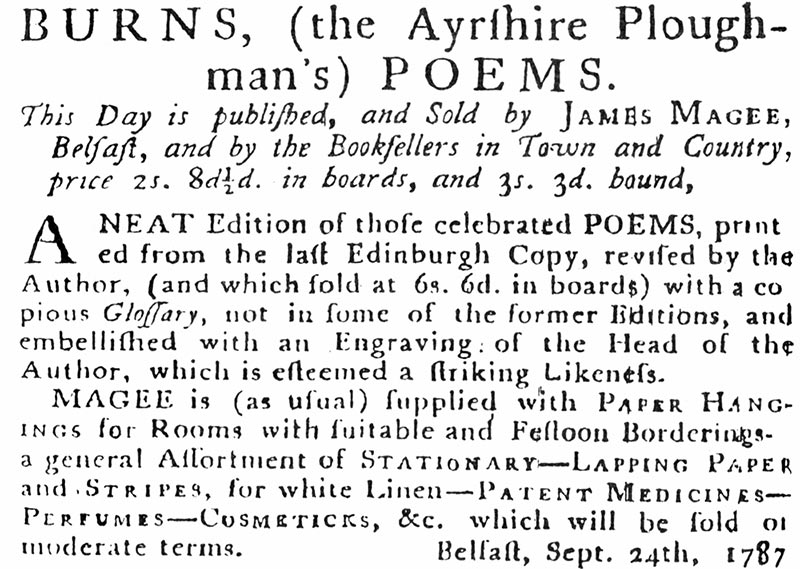Burns Corner
The Early Belfast Printings
The year 1786 was a highly significant year in the life of the 27-year old Robert Burns, disillusioned with the long hours and heart-breaking toil that went with tenant farming. He seriously considered emigration to the West Indies where he had been offered a job as a shipping clerk. Burns went as far as enquiring about a passage on the ship Nancy that was due to sail towards the end of August from the port of Leith to Jamaica. In an attempt however to raise a few pounds, Burns sent a selection of his poems for publication to John Wilson, a Kilmarnock printer, who on the 31st July, 1786, put just over 600 copies up for sale at three shillings each.
Burns and Wilson however were quite unprepared for the consequences of their creation as the poetry began to take Scotland by storm, projecting Burns virtually overnight from common ploughman to literary genius.
With thoughts of immigration now abandoned, Burns set off for Edinburgh on a borrowed pony. The journey took two days and when he arrived he found himself at the centre of attraction of a group of enlightened men of letters who had been making Edinburgh an internationally known intellectual centre. Indeed at this time there were many who claimed Edinburgh as the cultural capital of Europe.
Over the next few weeks no smart party was complete unless the ploughman poet was in attendance.
The poems however found equal favour in all ranks of society as the book was snapped up in farmhouses and cottages as well as country mansions.
The first Edinburgh edition was published by William Creech on the 21st April, 1787. The printer being William Smelie who also had been the editor and principal author of the first Encyclopaedia Brittanica, but as Burns had earned around £30 for the Kilmarnock edition he now found his earnings for the Edinburgh edition exceeding £850.
From the third publisher of his works, however, Burns was to receive not a penny.
The poetry of Burns hit the streets of Ulster during the latter half of 1786 when the Belfast Newsletter carried a number of pieces taken from the Kilmarnock edition. The poetry also became the main talking point among a number of small literary societies that had sprung up within the province.
James Magee, a shrewd if somewhat unscrupulous Belfast printer, saw a way of making money out of all the euphoria and on the 24th September 1787 he published two hundred copies of the poetry taken straight from the Edinburgh edition. Inside ten days all copies were sold, so Magee re-set the press and carried on printing. These of course were all pirated copies (pirated in the respect that Burns was not to receive a penny by way of royalties).
Magee became quite a successful businessman in the town and in 1792 helped finance the Belfast newspaper — the Northern Star. He lived into his ninety-second year and when he died was buried in his native Craigavad. His shop was at No 11 Bridge Street, Belfast, just opposite the present Northern Ireland Electricity offices. He called his shop the Crown and Bible Printers which probably reflected his religious and political persuasion. From his shop he sold musical instruments, patent medicines, state lottery tickets and of course the products of his printing press. But in 1787 his Belfast edition of Burns poems was his best seller.
Incidentally, a first Belfast edition can be seen in Burns Cottage, at Alloway in Scotland. Other early publications of Burns in Ulster were:
J Magee (1787, 1790, 1793, 1800); Archer Ward (1805); L Rae (1814); Joseph Smith (1818); A McDonald (1816); and Simms & McIntyre (1822).
In 1992 Blackstaff Press published two novels on the life and loves of Robert Burns.
Jim Heron

Over five thousand publications of ‘The Life and Works of Robert Burns’ have taken place and indeed have been translated into over 40 different languages. The first publisher was John Wilson of Kilmarnock in 1786, the second was William Creech of Edinburgh the following year in 1787. The third however was James Magee of Belfast also in 1787. The above advertisement appeared in the Belfast Newsletter on 20 September, 1787.
Next: Aspects of Ulster
Previous: The Rhymers
Contents: Ullans: The Magazine for Ulster-Scots, Nummer 3 Spring 1995

